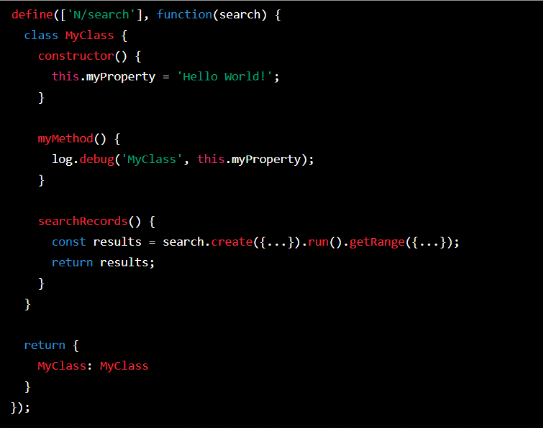SuiteScript is a powerful scripting language that allows developers to extend and customize the functionality of NetSuite’s cloud-based business management software. SuiteScript uses a modular approach to programming, where code is divided into modules that can be loaded and executed as needed. However, SuiteScript also supports writing code in a class structure, a more object-oriented approach to programming that allows for better organization and encapsulation of code.
This blog post will explore how to write SuiteScript using a class structure.

Defining a Class in SuiteScript
To write SuiteScript using a class structure, we first need to define a class using the SuiteScript 2.0 API. The define() function defines a class and takes two parameters: the class name and an anonymous function that defines the class methods and properties.
Here’s an example of how to define a class in SuiteScript:
In this example, we define a class called MyClass with a constructor method, a regular method called myMethod, and a method called searchRecords that utilizes the NetSuite search API. We then export the class using the return statement.
Using a Class in SuiteScript
Once the class is defined, it can be instantiated and used like any other object in SuiteScript. Here’s an example of how to use the MyClass class we defined earlier:

In this example, we use the require() function to load the MyClass module we defined earlier. We then instantiate a new instance of the MyClass class and call its myMethod() and searchRecords() methods.
Benefits of Using a Class Structure in SuiteScript:
- Using a class structure in SuiteScript has several benefits over the modular approach:
- Better Organization: Classes allow for better code organization by grouping related methods and properties into one entity.
- Encapsulation: Classes encapsulate data and behavior, preventing other parts of the code from accessing and modifying the internal state of an object.
- Inheritance: Classes can be extended to create new classes that inherit the properties and methods of the parent class, allowing for code reuse and extensibility.
- Polymorphism: Classes can be used interchangeably with other classes with a common interface, allowing for more flexible and modular code.

Conclusion
This blog post explored how to write SuiteScript using a class structure. Using a class structure, developers can create more organized, encapsulated, and reusable code that is easier to maintain and extend. While the modular approach is still valid for writing SuiteScript, the class structure provides an alternative worth considering for more complex projects.

About the Author
Fahad Latif
Senior Software Engineer - Folio3
Fahad Latif is a highly skilled and competent NetSuite developer dedicated to his work and passion for technology. In his free time, he enjoys indulging in the world of web series and books, allowing him to escape from the daily grind and expand his knowledge and imagination. His love for entertainment and his technical expertise make Fahad a well-rounded individual with a great appreciation for both the technical and creative aspects of life.